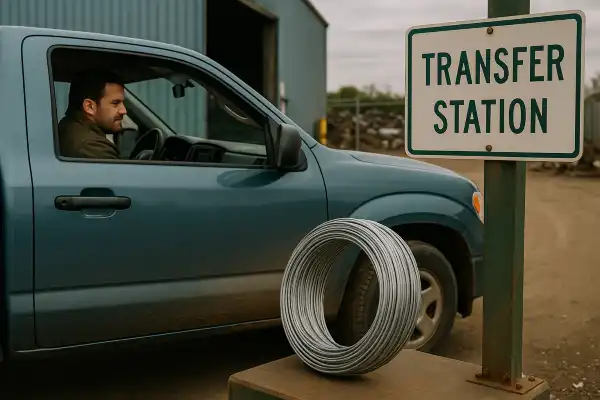Many people wonder if they can drop off scrap metal at a transfer station when cleaning out workshops, renovating homes, or handling demolition projects. The abundance of metal waste from appliances, construction materials, and industrial equipment creates confusion about the best disposal method.
During my years transitioning from mechanical engineering to sustainability writing, I’ve encountered countless facility managers and homeowners struggling with this exact dilemma. Understanding your local options can save time, money, and ensure proper environmental stewardship.
Can you drop off scrap metal at a transfer station?
Yes, many transfer stations do accept scrap metal for recycling, but policies vary significantly by location and facility type. Some transfer stations sort recyclable materials and separate them from items going to the landfill, while others do not sort their items and load everything together for landfill disposal.
The key difference lies in understanding what transfer stations are designed to accomplish versus dedicated scrap yards. This distinction affects cost, convenience, and the ultimate fate of your metal waste.

Understanding transfer stations vs scrap yards
Transfer stations are facilities where waste is temporarily stored before being transported to landfills or processing centers. Many transfer stations include recycling areas with separate hours from the main garbage disposal operations. These facilities primarily serve as consolidation points for municipal waste management systems.
Scrap yards, in contrast, are specialized facilities that buy, process, and resell recyclable metals. Professional scrap yards only accept items with valuable metal components that can be repurposed, and they pay customers based on type, weight, and current market prices.
From an engineering perspective, the fundamental difference is economic incentive. Transfer stations charge disposal fees because they’re part of waste management infrastructure. Scrap yards generate revenue by processing valuable materials, allowing them to pay suppliers.
Transfer station scrap metal policies
Transfer stations that accept scrap metal typically require materials to be at least 75 percent metal and specify that items must be sorted into designated recycling areas. Some facilities restrict recycling areas to residential customers only.
Common requirements include:
- Clean metal with fluids removed from machinery
- Separation from non-metal components
- Compliance with facility-specific size and weight restrictions
- Arrival at least 30 minutes before closing time for adequate processing
However, due to minimum tonnage policies put in place by station operators, it’s generally much more cost-effective for small quantities to use alternative disposal methods. This reflects the operational reality that transfer stations are designed for bulk waste management, not individual metal recycling transactions.
Cost considerations and fee structures
Transfer stations typically charge garbage fees ranging from $20 minimum for loads under 360 pounds to $105 per ton plus tax for heavier loads. These fees apply regardless of whether materials are destined for recycling or landfill disposal.
Scrap yards, conversely, may charge processing fees for certain items like CRT televisions, refrigerators, and air conditioning units that contain hazardous materials requiring special handling. However, for standard metals, scrap yards pay cash based on current market rates – typically $10-15 for appliances like washing machines, depending on market conditions.
The economic calculation becomes straightforward: if your metal has significant value (copper, aluminum, brass), scrap yards offer better financial returns. For low-value ferrous metals or when convenience outweighs profit, transfer stations may be appropriate.
When to choose transfer stations over scrap yards
Transfer stations make sense in specific scenarios:
Mixed waste loads: When metal comprises a small portion of larger cleanup projects, consolidating disposal at transfer stations eliminates multiple trips.
Geographic convenience: Transfer stations often have more locations and longer operating hours than specialized scrap yards.
Contaminated materials: Items with attached hazardous substances may be easier to dispose of through transfer station systems equipped for comprehensive waste handling.
Time constraints: For contractors managing tight project schedules, transfer station drop-offs can be more efficient than sorting and transporting materials to multiple specialized facilities.
Preparation and processing requirements
Successful transfer station metal disposal requires understanding facility-specific procedures. Most facilities require customers to secure loads before traveling and separate materials into designated recycling bins or areas.
Customers are responsible for unloading their own vehicles, and facilities don’t provide brooms or shovels. This operational approach reflects cost management priorities but requires users to come prepared with appropriate tools and labor.
Materials must be clean and dry, with all fluids removed from machines like lawn mowers. This requirement protects both facility operations and downstream processing equipment.
Optimizing your metal disposal strategy
The most effective approach often involves hybrid strategies. During my facility management consulting work, I’ve seen successful operations that:
- Sort high-value non-ferrous metals (copper, aluminum, brass) for scrap yard sales
- Consolidate low-value ferrous materials with general construction waste for transfer station disposal
- Call ahead to verify current market values and facility requirements
- Time disposal activities to coincide with favorable market conditions
Using a simple magnet test helps determine ferrous versus non-ferrous metals – if the magnet sticks, you have lower-value ferrous metal; if not, the non-ferrous metal commands higher prices.
Conclusion
Last month, while helping a manufacturing client clean out their facility expansion area, we encountered exactly this situation. Three pallets of mixed structural steel and copper piping needed disposal within a tight timeframe. We sorted the copper for direct scrap yard sale, generating $340 in revenue, while consolidating the structural steel with other construction debris for transfer station disposal at $65 total cost. The hybrid approach maximized both financial return and operational efficiency – exactly the kind of practical solution that balances engineering economics with environmental responsibility.
